from
Plant Diseases: Their Biology and Social Impact.
The Components of the Epidemic
With this background, the stage was set for the impending disaster. What were the important components that led to the tragedy? The human component should always be considered, and, in this case, a large population of human beings was dependent on a single food crop. The Irish population had grown rapidly following the introduction of the potato, and no significant alternative foods existed when the crop failed. The grains were needed to pay the rent to the English landlords. If the rent was not paid, the people were thrown off their land to certain starvation. Perhaps this dependence on one crop sounds foolish or ignorant today, but the current human population, now past the five billion mark, relies on essentially three species of plants to feed most of its people (wheat, corn, and rice), an issue we will return to in Chapter 14.
In addition to the human component, we should consider the important biological components that combined to cause the blight of the potato crop. All plant pathologists are familiar with the disease triangle, a memory aid describing the three factors necessary for disease: a susceptible plant, a pathogen capable of causing disease in the plant, and environmental conditions favorable for disease development. The potato crop was derived from a small supply of tubers that survived the lengthy trip across the sea to Europe. Thus, every plant in every field was nearly genetically identical, a desirable situation for the agricultural characteristics but a potentially dangerous situation for disease.
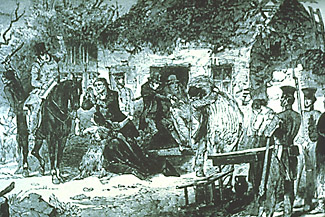
Fig. 1-8. "An Eviction." Tenants are thrown out of their homes in Ireland for not paying rent. Printed in the Illustrated London News, December 16, 1848.
In the early weeks of summer in 1845, records show hot and dry weather overall. The weather then changed, and overcast weather continued for six weeks, with temperatures 1.5-7 degrees below the average for the previous 19 years. Records throughout Europe indicate a particularly cool and rainy period. In just a few weeks, the vigorous green potato vines became a blighted mass of decaying vegetation. When the tubers were dug from the ground, some were rotted, but many appeared to be sound. Later, however, these potatoes, too, rotted away in the storage bins. Throughout Europe, the potato crops failed, but the disaster was worst in Ireland because of the nearly complete dependence of Irish peasants on the potato for their food. Note that even though the rainy weather affected all crop yields to some degree, the blight epidemic was specific to the potato. Something new and frightening was occurring in the potato fields, and the answer to the mystery lay in the third component necessary for disease--a virulent pathogen capable of infecting the potato crop.
It is interesting to consider, at this point, the state of science in the mid-1800s in Europe. Only wealthy people generally had the leisure time and education to look about and consider how the world operated, so most scientists were men trained in medicine or religion. The microscope had been invented nearly 200 years previously by Anton van Leeuwenhoek in The Netherlands. Robert Hooke, a physicist in England, first described the cells in plant tissues, although the concept that cells are the basic unit of plant and animal tissues was not proposed until 1838, nearly 150 years later. Hooke also first observed fungi through his microscope in 1667.
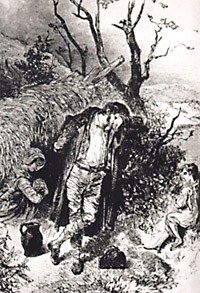
Fig. 1-9. "After the Eviction." Homeless families had to find shelter in the countryside. Printed in the Illustrated London News, December 16, 1848.
Spontaneous generation was the prominent theory to explain the presence of teaming populations of microbes in diseased or dead tissues. When, in 1845, a white fungus was found on the blighted potato vines, it was considered to be the result, rather than the cause, of decay. One common explanation for the rotted crop was that the plants took up too much water in the rainy weather. Many observations of diseased plants had been made over the centuries, however, and many thoughtful people had contributed clues to the solution of the puzzle of plant disease. The potato blight attracted the attention of a number of biologists and brought many of the clues together. Rainy seasons had occurred before without such losses. This new phenomenon required a new explanation.
A pathogen is something capable of causing disease. In the case of the potato blight, the pathogen is a fungus that parasitizes the potato plant. A parasite derives its food from another living organism and lives in intimate contact with its host. In nature, parasites are associated with nearly all living organisms. We are all familiar with the fleas, ticks, and intestinal worms that annoy most pets. A healthy animal can maintain reasonable populations of such parasites without necessarily being diseased. Similarly, with wild plants and animals, parasites that do not cause noticeable disease should not be called pathogens.
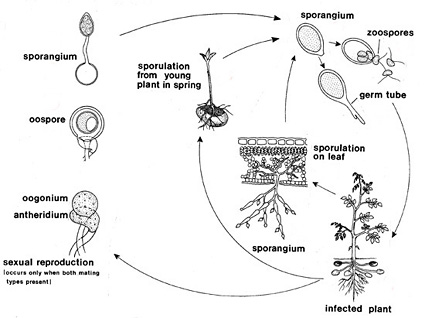
Fig. 1-10. Life cycle of Phytophthora infestans, causal agent of late blight of potato and tomato.
The blight fungus parasitizes potato plants and closely related plants in South America. Farmers there grow an enormous number of potato cultivars that vary in their susceptibility to the parasite, so that even though some loss to the parasite occurs, devastating epidemics are avoided. The technology of modern agriculture, and of vegetatively propagated plants in particular, leaves crops genetically uniform and thus uniformly susceptible to a parasite. This situation can result in a severe epidemic in which the parasite not only derives food from its host but increases so rapidly that it becomes a pathogen, causing disease and loss.
The blight fungus arrived aboard a ship from South America just as the potatoes had. It is likely that blighted tubers carrying the fungus had been taken aboard many times previously, but that the tubers were eaten or had rotted before arriving. Perhaps faster crossings allowed some of the tubers carrying the fungus to survive and be planted in Europe. Perhaps, also, the environmental conditions were so favorable for infection by the fungus in 1845 that the parasite was able to establish itself rapidly upon arrival. Certainly, the narrow genetic base of the existing potato plants left them vulnerable to the invading fungus.
The fungus itself is barely visible. It appears as a whitish mildew on the surface of infected potato leaves and stems when it emerges through the stomata (air exchange pores) in humid weather. Microscopic treelike hyphae grow away from the plant tissue, producing lemon-shaped sporangia at their tips. A sporangium (plural: sporangia) is a structure that contains spores, the reproductive units of a fungus. The sporangia are usually dispersed by air currents to neighboring plants and can travel easily to nearby fields when the air is moist. They dry out and die at high temperatures or after traveling long distances. At cool temperatures such as those that prevailed in 1845, a change occurs in sporangia when they land on a wet potato leaf or stem. After a few hours, the cellular material inside the sporangium is converted into about eight wiggling zoospores, each with two flagella to aid in movement. The zoospores swim out of the sporangium and attach themselves to (encyst on) the leaf surface. A small germination tube infects the plant. From the tiny infection sites, an extensive network of threadlike hyphae penetrates between the cells, absorbing nutrients to feed the growing fungus. Brown lesions of dead plant cells and newly produced sporangia begin to appear as soon as three to five days after infection, increasing the epidemic. The fungus can produce many generations of sporangia in a short time and rapidly colonize all available potato tissue. A whole potato plant can be left a slimy mass in less than three weeks.
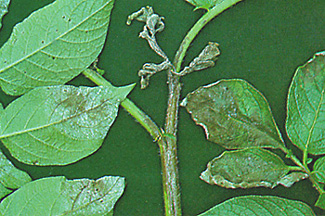
Fig. 1-11. Sporulation of Phytophthora infestans on potato leaves. Sporangia are produced on hyphae that emerge through stomata in the leaves.
Germination and infection always require water on the leaf surface. At higher temperatures (over 68°F or 20°C), the sporangia germinate by producing a single germination tube rather than zoospores. Thus, the number of potential infections from a single sporangium is greatly reduced in warmer environments, although disease is not eliminated.
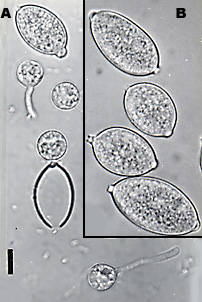
Fig. 1-12. Phytophthora infestans. A, zoospores produced within the lemon-shaped sporangia (B).
The favorable conditions for the blight, extended periods of cool and wet weather, are explained by the biology of the parasitizing fungus. Sporangia best survive dispersal by air when the air is humid, and water is necessary for infection by the fungus. In addition, zoospores are produced at cooler temperatures, which maximizes the number of potential infections possible from a single sporangium. The cool, wet environment of Ireland was particularly favorable for this new disease, now known as late blight.
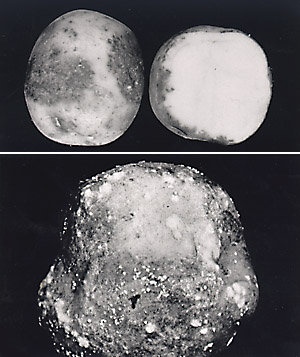
Fig. 1-13. Potato tubers infected by Phytophthora infestans. Top, tuber in the early stages of infection; bottom, tuber showing sporulation of the fungus after storage under moist conditions.
A final explanation is still needed. How do the tubers become infected by a fungus that invades the leaves and stems? It is now known that sporangia from the leaves are washed by water into the soil, where they can infect the tubers. Potato growers have learned to "hill up" the soil around the stems of young potato plants to increase the depth of soil that sporangia have to traverse to attack the tubers. In addition, potato vines are usually killed before harvest with herbicides, mechanical cutting, or by frost, to protect newly dug tubers from exposure to sporangia on the leaves and stems. The fungus is incapable of surviving temperate winters in the soil, but it spends the winter, well supplied with food, in infected tubers in storage bins and discard piles at field edges. The cool environment of storage bins is very conducive to fungus growth in infected tubers, causing further losses. If conditions are moist in storage, the fungus may even spread to previously healthy tubers. Any infected tubers that survive the winter without being completely destroyed by the fungus will serve as a source of new sporangia on the developing plants. So begins a new blight epidemic.
Introduction
The Arrival of the Potato in Europe
The Potato Plant
The Components of the Epidemic
The Birth of Plant Pathology
Protecting Potatoes from the Blight
Lessons from the Potato Famine
Selected Readings
RETURN TO APSnet FEATURE STORY
